 Finding God At
Finding God At
CORNELL
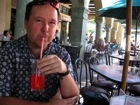
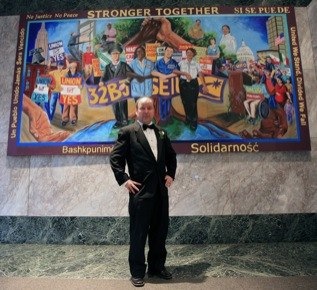 Peter, Best Man to no-longer-bachelor, Ard Louis, (see Ard's story on the Oxford page)
Peter, Best Man to no-longer-bachelor, Ard Louis, (see Ard's story on the Oxford page)
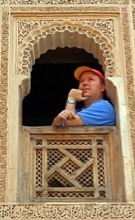
How Did We Not Know?
By Peter Clark
[Before Cornell] Harvard’s case studies also contributed to my sense of alienation from poverty. Then I found myself flying on an aging DC-8 into Ayacucho, Peru’s heart of darkness. My real life case study was beginning.
The son of missionary parents, Dr. Peter Clark grew up in Honduras. He graduated from Wheaton College in 1984 and, two years later, from Harvard’s Kennedy School of Government with a master’s degree in public policy.
Peter spent the next five years as the country director for World Relief in El Salvador, following the 1986 earthquake. In 1991, Peter invited Jeff Barneson, Kelly Monroe and students of the Harvard Graduate School Christian Fellowship to help transform a former city garbage dump in San Salvador inhabited by 8,000 people escaping war, drugs, and the memories of terrorism. In 1992 the United Nations awarded Peter and colleagues the Habitat Scroll of Honor to the World Relief El Salvador Housing Reconstruction Program.
Peter later completed his Ph.D in Adult Education and Social Science at Cornell University on the political economy of international development. He is frequently invited to offer management courses in Eastern Europe. And his non-proft organization for indigenous community storytelling and development, ARCA, has helped empower poor communities in Africa, Afghanistan and Central America.
Each summer Peter, Ard Louis, and other friends tour a developing country, by bicycle.
*The names of Peruvians in this story have been changed for their protection.
How Did We Not Know?
By Peter Clark
You cannot understand until you see.
Old Incan proverb.
The blood of the martyrs is the seed of the church.
Tertullian, Apologeticus
At least two of the great human tragedies of the twentieth century took place under the penumbra of a complicitous silence. Allied soldiers who liberated Nazi concentration camps during the waning days of World War II could not erase the memory of mass graves and ovens, of meat hooks, and of thousands of gaunt Jewish faces crying tears of joy upon realizing they had been freed. And those who went to Cambodia after the fall of the Khmer Rouge and saw the stacks of human skulls from the killing fields also tried, sometimes in vain, to make sense of a world turned upside down. Witnesses in each case often say that one of the most troubling questions for them was: “How did we not know?”
My years at Harvard’s John F. Kennedy School of Government have begun to fade, with time, into one long vigil of overlapping case studies. I can no longer remember what I suggested President Kennedy should do to solve the Cuban Missile Crisis, where I told the government of Bangladesh to drill new wells, or why I said I admired Chicago’s Mayor Daley.
But I do remember how eager I was to graduate and begin applying some of the analytical skills I had acquired. As a child of missionaries, raised in Latin America, I grew up with the poverty of the Third World, and I wanted to “do something about it.” As a Christian, I wanted to use my concentration in international development to help create practical solutions to human suffering. So I spent my first five years after the Kennedy School coordinating a large earthquake reconstruction program in San Salvador, El Salvador. The job brought with it many of the challenges we had studied at Harvard: How do you mobilize community support for a housing pro- gram? What contacts do you make in the Salvadoran government to get the project going?
In many respects, I had an ideal job for someone who wanted to accomplish something tangible for the poor—including extensive funding. Yet I sensed something was missing. I was comfortably ensconced behind a psychological curtain that kept me strangely removed from understanding and empathizing with the poor. Harvard’s case studies had sharpened my mind, but in a subtle way they had also contributed to my sense of alienation from poverty. I felt as if I were somehow hovering over the world, casting a sweeping critical eye on “development problems,” analyzing their “structural causes,” and resolving “situations” with a few quick strokes.
But then God brought my career to a turning point, a moment when the barrier of detachment was broken, pierced, one might say, by the sudden, rushing realization that much of the world actually lives out the case studies I had merely studied at the Kennedy School. These were real people in real contexts with real-life problems. Not only that, but many of their problems were enormous—much larger and more frightening than in the cases we had studied. Thus I found myself, on the morning of March 3, 1991, flying on an aging Faucett Airlines DC-8 into Ayacucho, Peru’s heart of darkness.
My real-life case study was beginning.
Peru, March 1991—The eastern slopes of the Peruvian Andes, that swath of land that runs from Peru’s northwestern border with Ecuador to its southeastern border with Chile and Bolivia, now constitutes the chief battleground on which the “People’s War” is being waged between the Peruvian army and the guerrilla group that has come to be known (and feared) as the Shining Path. The fighting has been fiercest on the mountain slopes nearest Ayacucho. And for ten traumatic years, the Indian Quechua-speaking evangelical church has been caught in the cross fire.
“Just this past year thirty-two of our churches in the presbytery of Union Pichari have been burned to the ground,” a church leader from IPNP (National Presbyterian Church of Peru) tells me in Lima. “This is happening because we are currently the largest evangelical denomination in the region, and also because many of our churches happen to be located on the Shining Path’s supply routes.”
At the general hospital in Ayacucho, the face of forty-five-year-old León Huaman Huacho, a Quechua Indian Pentecostal, every now and then convulses with silent sobs that seem to well up from deep within as he describes a nighttime killing by the Shining Path in his Andean town of Ccano. Just a few weeks earlier, members of his family were gunned down in church while they knelt in an all-night vigilia (or prayer meeting). He tells me:
“Thirty-three were killed, seven wounded. Since 1984 our small town of three hundred people has been forced by the army to organize into civil defense. Two months ago the local army post there was closed, and the army people left. Then the Shining Path threatened that we were going to pay, because we were servants of the military. At about 11:00 P.M., while our church was in an all-night prayer meeting, about forty men drove up in several trucks. They locked the church doors and then they began shooting. They had FAL rapid-assault rifles. Then they poured gasoline on all the benches and set the church on fire, people, everything. As the guerrillas ran out, my wife was there. She says they yelled, ‘This is how dogs die.’”
It is ironic that the Quechua evangelical church, while being persecuted by the Shining Path, is also distrusted by the Peruvian army. Some Quechua Indians, frustrated with destitution and powerlessness, have joined the Shining Path, making the Quechua church the frequent target of army massacres. I have seen this catch-22 before in the mountains of Guatemala, where Mam, Quiche, Kakchiquel, Ixil, and other Indian groups are trapped in a no-win situation. It seems also that the government confuses the church’s biblical stance against greed, selfishness, and corruption with the Shining Path’s extreme anticapitalist ideology. Yet where church members have joined the rural civil defense, they have become natural military objectives for the Shining Path. Many church members have died in community-wide massacres that occurred when Peruvian army redeployments, having pressed civilians into defense patrols, then departed, leaving these Indian villages almost defenseless against the Shining Path’s inevitable “just retribution against collaborators.”
Why is all this happening? Why are Peruvian evangelical Christians the target of violent persecution? To understand that, one must first understand how the Shining Path, or Sendero Luminoso, came to be.
Lima, Peru—My introduction to the Shining Path is a poster plastered to an exterior wall of San Marcos University in Lima. It depicts Abimael “Gonzalo” Guzmán, founder and leader of the movement, looming over a road filled with workers and peasants marching towards him. The road is bathed in a kind of apocalyptic light—a shining path. The caption reads: “President Gonzalo Guides Us by the Light of Truth.” There is no mistaking the messianic theme here. For Abimael Guzmán, however, it was orthodox communism rather than Christianity that promised redemption from oppression. Peruvian kids (with Peter, a kid at heart)After a stint as a philosophy professor, Guzmán was sent to study at China’s elite Red Guard School. In 1968 he resumed his former philoso- phy post in Peru, firmly committed to dogmas of the Chinese Cultural Revolution— dogmas that would serve as the “guiding lights” of the Shining Path. “Prolonged People’s War” was to be the chief insurrectionary model.
Peruvian kids (with Peter, a kid at heart)After a stint as a philosophy professor, Guzmán was sent to study at China’s elite Red Guard School. In 1968 he resumed his former philoso- phy post in Peru, firmly committed to dogmas of the Chinese Cultural Revolution— dogmas that would serve as the “guiding lights” of the Shining Path. “Prolonged People’s War” was to be the chief insurrectionary model.
An eventual split with China reinforced the Peruvian group’s isolation. The split also drove it to seek financial independence by gaining control of the drug trade in Peru’s eastern jungles. Fortified with careful political indoctrination of its members, the Shining Path took to the path of violence, claiming fifteen thousand lives since 1980, five thousand in the state of Ayacucho alone.
Abimael Guzmán’s vision is to turn the world ultimately toward communism. He criticizes Soviet communism for turning its back on Stalin, for not going far enough. He views his movement as the de facto government of Peru, and the true spiritual center of world revolution. His tools of choice are systematic sabotage, ferocious terrorism, and stringent adherence to ideology ruthlessly purged of all sentimentality.
The seven survivors of the recent Ccano massacre are arrayed in beds in the dimly lit surgery ward. In the far corner lies a five-year-old boy riddled with five bullet wounds. Sixty-three children lost one or both parents.
Huanta, Peru—I catch a ride in a Toyota on its way to Huanta, a picturesque town thirty-five miles north of Ayacucho. Huanta is headquarters to Radio Amauta. Apart from periodic Shining Path tapes with “revolutionary” messages (which the station staff must air if they have any interest in continuing to live), Radio Amauta’s one-kilowatt transmitter beams evangelical programming in Quechua to parts of central and southern Peru. The twisting highway takes us past long lines of civil defense ronderos making the trek to Ayacucho. Not all seem able-bodied; some are old men, some too young. A few carry World War I vintage rifles; others have just pieces of wood painted to look like rifles; others carry poles with a knife blade tied to their end.
One of the passengers in the car—Lorena Mercedes Cruz—is a young, bright economics graduate of the University of San Cristobal and an active member of the Presbyterian church. Still single, Lorena has taken in ten children orphaned by army and Shining Path massacres and decided to raise them by herself. Together they survive with the help of church subsidies and thank-yous from aging peasants. “The first few months I had them,” Lorena tells me, “whenever we went into town, they would whimper and cling to my skirt every time they saw a soldier. I cannot imagine what they have seen in their brief lives.”
In Huanta, we sit down with several Presbyterian church leaders, including Hector Castro, IPNP’s current president. Stories of past attacks tumble out: The Espiritu Alto church, on the outskirts of Huanta, was dyna- mited by the army in 1987, because authorities feared the church building might be used by the Shining Path on nights when there were no services. In 1988 the Shining Path attacked civilians on the highway between Ayacucho and Huancavelica, killing twenty, eight from the local Presbyterian church. During an indiscriminate army offensive in 1984, six leaders of the Presbyterian church in Kallqui were pulled out of a prayer meeting and shot. In September 1990 the Shining Path blew up the large Presbyterian church in Huancavelica. In June 1989, during an evening evangelistic service in the Presbyterian church in Carhuauran, the Shining Path killed nine. And on and on.
I am aware of the spiritual-ideological roots of the Shining Path movement but astonished by the level of the atrocities. I find myself asking again, “But why are churches being targeted by the Shining Path?”
“Some denominations have been preaching that the Shining Path is a demonic movement and have actively opposed it,” replies Hector, the IPNP president. He continues, choosing his words carefully:
“We have tried to maintain an officially neutral position, preaching against violence on either side. However, I suspect the Shining Path does not trust us completely because of our church’s origins with American missionaries. They claim we are a foreign ideology wrapped in the trappings of religion, offering the Quechuas spiritual panaceas to keep them in poverty.”
Indeed, in the early 1980s, inflamed with anti-Western, antireligious sentiment, the Shining Path drove IPNP’s American founding missionaries from their homes in the central Peruvian Andes, leaving denominational control to indigenous leadership. But only two percent of IPNP members have received any professional training. More than eighty percent are still illiterate; seventy percent are poor peasant farmers. Their faith, in many cases, is extremely deep, but they need to be at least functionally literate to coordinate the complex activities of a large denomination with 182 different congregations.
Despite this poverty, the Shining Path defines the evangelical church as a part of the status quo infrastructure, an entity promoting a form of social cohesion, identity, and pattern of belief that runs counter to the one they intend to propagate. As such, it must be weakened relentlessly and systematically until it collapses. People’s War orthodoxy clashes with Christianity as each of them stakes claim on the soul of the Indian—one for indoctrination, the other for life. Churches are thus targeted in order to “decapitate Christianity”—for when the church leaders are silenced, then the “body will melt.”
Those are not mere words. “A revolution is not a dinner party nor the writing of an essay,” states a piece of Shining Path dogma borrowed from Mao Tse-Tung. “A revolution is an insurrection, an act of violence by which one class overthrows another.” But these are poor, defenseless Quechua Indians, shot in the back while they prayed. They do not fit the profile of a “class that needs to be overthrown” by violent revolution. That, however, is not a logic accessible to those steeped in “Gonzalo thought,” a potpourri of Maoist, Marxist, and Leninist thinking spiced up with Guzmán’s own theorems.
The return drive from Huanta to Ayacucho affords time for reflection. I can barely take in the majesty of the mountains and soaring Andean condors. I am more moved by the dignity of the church and their humaneness under unbearable suffering. And I am struck by their exemplary faithfulness in the face of what surely must look to many as meaningless tragedy, even desertion by God. But they do not seem to think that God has deserted them, for the power of God is manifested daily to them in a thousand little deliverances and in a tranquillity that transcends understanding. They are thankful to be alive. They trust God to deliver them from evil, but if that is not his will, they seem prepared to die as a way of participating in the sufferings of Christ. Their faith has reordered their relationship to the world and to the future in a way that I rarely have encountered in people who do not have faith in some larger reality or some final justice, but even more than that, who do not have some inward sense of joy and integrity that sustains them.
Like the martyrs of the Old Testament, or Christians in the first-century church, these Peruvians live out the existential tension between God’s infinite ability to protect his children against harm and, on the other hand, the mystery of suffering for the sake of the kingdom. It is the tension embodied in the life of Jesus himself, whose moment of greatest shame and weakness— on the cross—was also the moment of his greatest spiritual victory, the triumph over satanic evil. It is the tension inherent to the concept of a God whose perfect strength is shown most clearly in the weakness of human vessels. One senses that the Shining Path has underestimated the resilience of the Peruvian church, its ability to renew itself in faith, and the depth of its roots in the Christian message of ultimate redemption for those who endure to the end. In attempting to “decapitate the church,” the Shining Path overlooked one little thing—the fact that the head of the church is Jesus Christ himself.
Back at the general hospital in Ayacucho, Hector Castro, the Quechua pastor, says to one of the wounded women from Ccano, “I hope this does not make you lose your faith.”
“I am ready to join my Lord at any time,” she replies.
Since the mid-1980’s, the Peruvian government has strictly censored news reporting on Shining Path “activity.” Few international reporters make it into the Ayacucho region, because of its remoteness and its security problems. As a result, widespread international public opinion on the killings being committed year after year has been nearly nonexistent. News of the massacre at Ccano, for example, has probably never made it to the outside world—or, for that matter, into a Kennedy School case study.
And yet there are simple things people can do to help the Quechuaspeaking church in Peru. They need assistance that is channeled not to bureaucratic non-Quechua agencies based in Lima but directly to Quechua church leaders with deep local roots, in a way that enables them to design their own church-based solutions. Politically, they need the moral force that is generated by international public awareness and by polite but firm contact with the Peruvian government concerning the mayhem against the church.
The persecution of Quechua Christians in Ayacucho and its surrounding regions has not reached the proportions of what was experienced by Jews in Europe in the 1940s, by Cambodians under Pol Pot, or by Russians (including Christians) under Stalin. But what is clear is that the seeds of a new incomprehensible evil are being sown in the Peruvian highlands. “There is in Peru,” Hector told me, “an old Inca saying that goes, ‘You cannot understand until you see.’”
As “lights in the world,” we who have been given those opportunities that come with affluence, literacy, and access to the media have a deep obligation to uncover evil, especially where the evil is launched against a helpless and silenced people. Time may come when we ask, perhaps a little too late, “How did we not know?”
Madrid, Spain, 2010—Two decades have passed since my time in Peru, but the memories have not faded. The faith of the Quechua Indians has helped to reunite my own heart and mind. I have also come to see how unhinged people can become if left to their own Godless philosophies and ideologies. For this reason, I hope that I will never do development work that does not take into account the complexity of human motives and the breadth of human needs.

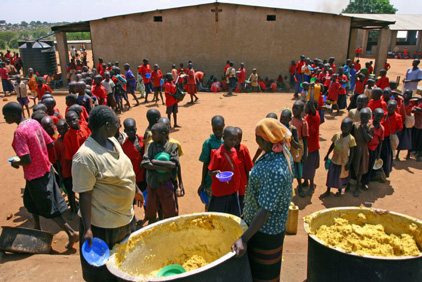 One of our shoots in Kitgum was at a school with 4,000 students. Most of the students are orphans, either due to AIDS or a war that has lasted for 20 years. The school provided a free lunch.
One of our shoots in Kitgum was at a school with 4,000 students. Most of the students are orphans, either due to AIDS or a war that has lasted for 20 years. The school provided a free lunch.
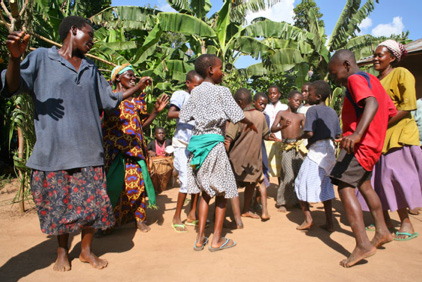 Often when we filmed in rural communities, the entire village would break out in impromptu dances.
Often when we filmed in rural communities, the entire village would break out in impromptu dances.
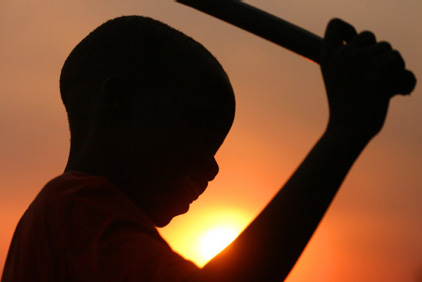 Many children in northern Uganda are affected by violence. More than 30,000 have been abducted and forced to join the Lord’s Resistance Army (LRA), a local guerilla movement.
Many children in northern Uganda are affected by violence. More than 30,000 have been abducted and forced to join the Lord’s Resistance Army (LRA), a local guerilla movement.
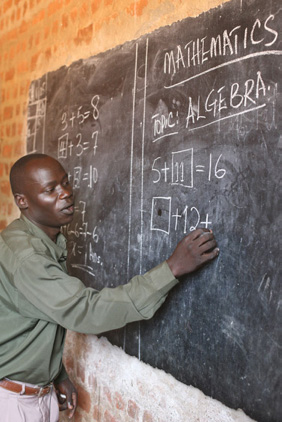 Teacher posing math problems in school at Kitgum, northern Uganda.
Teacher posing math problems in school at Kitgum, northern Uganda.
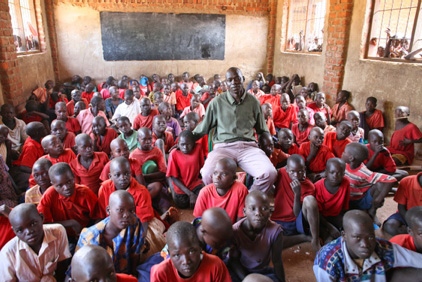 Elementary school class in Kitgum, northern Uganda. Average class size in this school was about 70, and students sit on the floor. The teacher’s arm rests on Stephen’s shoulder, a student with spinal bifida.
Elementary school class in Kitgum, northern Uganda. Average class size in this school was about 70, and students sit on the floor. The teacher’s arm rests on Stephen’s shoulder, a student with spinal bifida.

